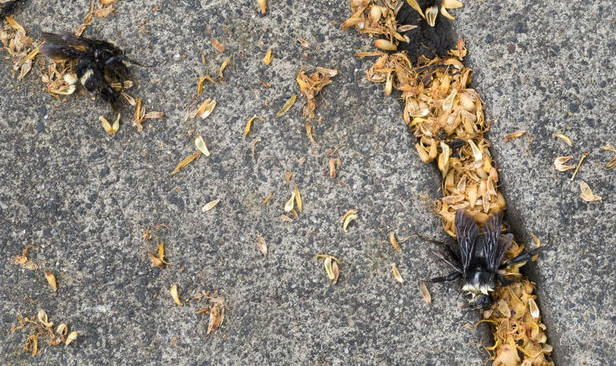No-tillers are getting some sober reminders about the proper use of insecticides after a high-profile investigation has begun into the deaths of tens of thousands of bumblebees in Oregon.
According to the Oregonian newspaper, the Oregon Department of Agriculture is investigating what caused the deaths of hundreds of bees in Hillsboro, Ore., just days after an estimated 50,000 dead bumblebees were discovered in a Wilsonville, Ore., parking lot.
|
|
Hillsboro alerted the state after discovering hundreds of dead bees under a linden tree in downtown Hillsboro on Friday. State agricultural officials took samples from the tree in Hillsboro Friday night and returned to Hillsboro on Monday to obtain more samples.
In Wilsonville, state officials confirmed the pesticide Safari was the culprit in the deaths of thousands of bees. The department is continuing to do interviews and investigate whether to take any enforcement in the Wilsonville incident, according to Bruce Pokarney, the department’s director of communications.
But officials say while Hillsboro also applied Safari, there’s no confirmed link between the chemical and the bee deaths. While there are similarities between Hillsboro and Wilsonville instances, there are differences, too — primarily timing, officials say.
Landscapers sprayed the Wilsonville trees June 15. Hillsboro sprayed trees in both the downtown and Orenco Station areas in March. This was the third year the city sprayed trees, primarily to kill aphids.
While Hillsboro used Safari, the same chemical deployed by a landscape company on 55 linden trees in a Wilsonville Target parking lot, Preston said he hasn't heard of any other bee die-offs in town.
Scott Hoffman Black, executive director of The Xerces Society for Invertebrate Conservation, said the cost of losing valuable pollinators, such as bees, “far outweighs” the benefits of having well-manicured trees and lawns.
While officials are still investigating the cause of the die-off in Hillsboro, Black suspected Safari is "likely the cause." Bees are smart, according to Black, and won't visit a tree if it's not flowering. If trees are sprayed prior to flowering, the flowers would still be toxic to bee populations, Black said.
"These trees didn't start to flower until a few weeks ago," Black said.
Linden trees can also be toxic to bees under some circumstances, according to both Preston and Black. But Black said that toxicity is very unusual, and typically occurs in drought conditions when the tree's nectar is concentrated.
Follow The Label
Ohio State University Extension issued some recommendations recently about sensitivities surrounding pollinators.
“As famers get close to soybeans flowering (growth stages R1-R2), we need to bring up an important issue related not specifically to honey bees, but to pollinators in general (albeit honey bees in soybeans is still a concern),” the university says. “Although soybeans are a self-pollinated crop, generalist pollinators, such as bumblebees and other solitary bees, do visit soybean fields regularly during the crop’s flowering stage.
“These pollinators will also visit other nearby sites, offering pollinating services to other plants including flowers and if present, vegetable crops. Research out of Iowa State University indicates that many generalist pollinators make regular visits to soybeans and are at danger from insecticide sprays; researchers at the OARDC have recently joined these studies.”
Luckily, OSU says, there are few insect pests that reach economic levels during flowering in Ohio; almost all occur during pod development or seed fill stages (R3-R5).
“Thus, when following an IPM strategy, little insecticide should be sprayed at flowering because a treatment application, as we all know, should only be applied when needed — when a threshold is reached, and not applied as a preventive application.
“However, we’re aware that many growers are adding insecticides to spray tanks when applying fungicides for plant health purposes and even late applications of herbicides because: ‘Well, I’m going over the field anyway so I thought I’d add an insecticide for insurance purposes! The insecticide is relatively cheap and soybeans are worth so much!’
“As we have always stated, we do NOT recommend this practice, and feel an IPM approach is much better for everyone and everything, including the environment and in this case, pollinators. We NEVER recommend an insecticide application unless there is a need. And with the recent information and concern about generalist pollinators, this caution is even more important.”
Ohio State says reports of the bumblebee deaths, “was with an insecticide that had the warning about being highly toxic to bees on its label, and the need to NOT spray flowering plants or trees.
"Growers and applicators should remember, having read the label, that most insecticides have a statement about spraying around bees and on blooming crops.”
Ohio State advises farmers and applicators maintain good communications with beekeepers near their fields to prevent and limit unintended problems. "Applicators should avoid spraying when bees are active in the field with flowering crops or weeds."
Other times to avoid spraying are from 10:00 a.m. to 7:00 p.m. or when temperatures are above 65 degrees F. On extremely hot days, bees may be active later into the evening.
Follow label precautions that relate to drift and be aware of the potential risk to neighboring crops or areas. Filter strips or other conservation areas that border fields may have flowering plants with foraging bees. Bees have a long range and can forage up to two and one-half miles from the apiary.

 Only a scattering of dead bumble bees remain beneath a single linden tree in Oregon that is now shrouded in protective netting. Passersby report seeing the sidewalk "piled" with dead bees before the tree was draped on Saturday. (Oregonian photo)
Only a scattering of dead bumble bees remain beneath a single linden tree in Oregon that is now shrouded in protective netting. Passersby report seeing the sidewalk "piled" with dead bees before the tree was draped on Saturday. (Oregonian photo)




Post a comment
Report Abusive Comment